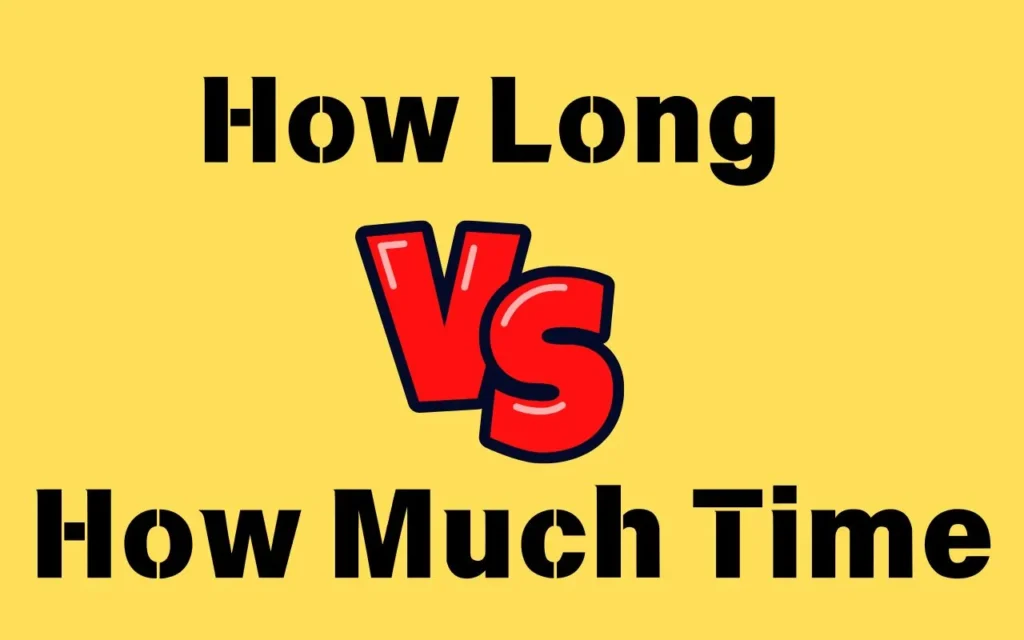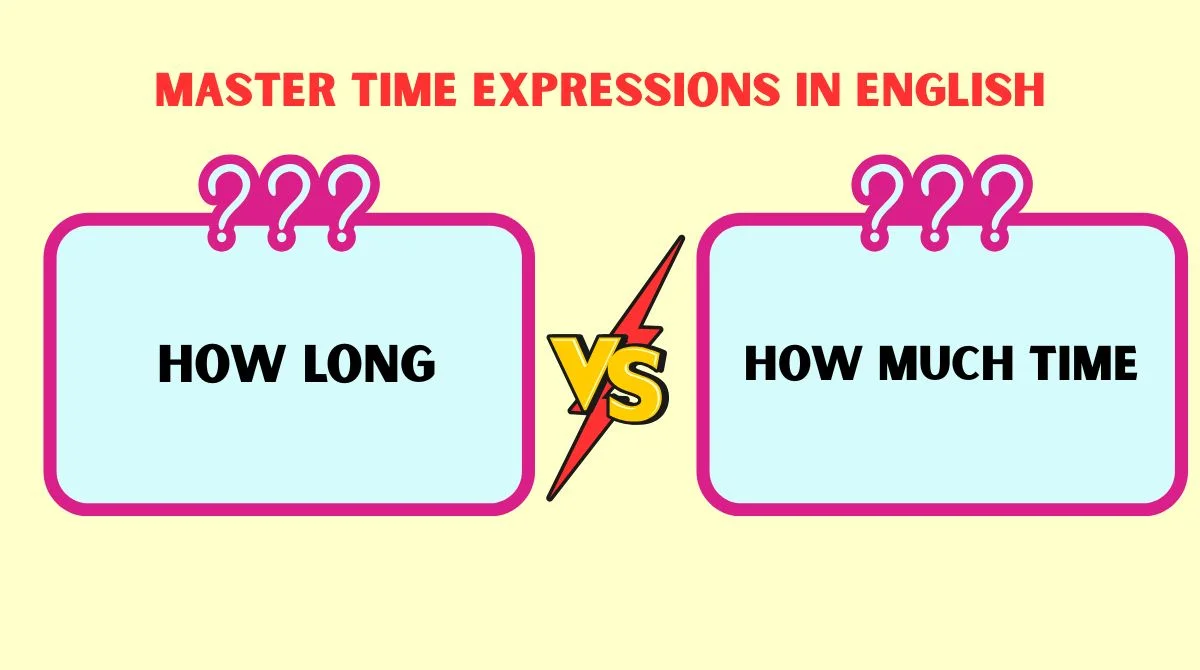Last updated on September 23rd, 2025 at 08:10 am
Understanding how to express time accurately is a vital part of mastering the English language, especially in American English.
Whether you’re chatting casually, writing professionally, or planning a project, knowing the difference between phrases like “how long” and “how much time” can significantly improve your communication skills.
In this guide, we’ll explore the nuances of these phrases with examples, practical contexts, and grammar tips to ensure you use them correctly.
By the end, you’ll have a comprehensive understanding of how to use “how long” and “how much time” effectively in both casual and formal situations.
Key Differences Between “How Long” and “How Much Time”

How Long
“How long” is commonly used to ask about the duration of an event or activity. It’s flexible and works well in both casual and formal contexts. For example:
- Casual: “How long did you wait for the bus?”
- Formal: “How long have you been working here?”
This phrase can refer to a range of time measures, such as minutes, hours, days, or even years. It’s versatile and appears in daily conversations, academic discussions, and professional communications alike.
How Much Time
“How much time” seeks a precise measurement of time. It’s often used in contexts that require specificity, such as schedules or deadlines. For example:
- “How much time do we have left to finish this task?”
- “How much time did you spend on this report?”
While “How long” is broader in scope, “How much time” tends to suggest formality and precision. You’ll often hear it in professional meetings, academic settings, or detailed planning sessions.
When to Use “How Long”
Common Uses:
- General Duration:
- “How long did the meeting last?”
- “How long does it take to drive there?”
- Physical Measurements:
- “How long is the table?” (referring to length)
Grammatical Structures:
- Present Perfect: “How long have you lived here?” (Action started in the past and continues to the present)
- Past Simple: “How long did you wait?” (Action completed in the past)
Common Mistakes:
- Incorrect: “How long time did you wait?”
- Correct: “How long did you wait?”
Detailed Examples:
- “How long will this take?” (Asking about the estimated time required for a task.)
- “How long have you been studying English?” (Inquiring about the duration of an ongoing activity.)
- “How long does it take to bake a cake?” (Requesting a typical time frame.)
Cultural Contexts:
In American English, “How long” is widely understood, but subtle differences in tone or phrasing can emerge depending on the region. For example:
- In informal conversations, contractions like “How long’ve you been here?” are common.
- In formal settings, the complete structure (“How long have you been here?”) is preferred.
When to Use “How Much Time”

Common Uses:
- Exact Scheduling:
- “How much time do we need for the presentation?”
- “How much time is left before the deadline?”
- Formal Inquiries:
- “How much time will this process take?”
Grammatical Clarity:
- “How much time” focuses on precision and is often accompanied by context requiring exact answers, like deadlines or appointments.
Examples:
- Academic: “How much time is allocated for the exam?”
- Professional: “How much time do we have for this meeting?”
Nuanced Use Cases:
- “How much time” is frequently used when planning tasks, managing schedules, or discussing resource allocation. For example:
- “How much time do you need to finalize this report?”
- “How much time should we dedicate to each presentation slide?”
Practical Tips:
- Use “How much time” when you want exact numbers or specific answers.
- Combine with modifiers for clarity: “Exactly how much time do we have left?”
Comparing “How Long” vs.“How Much Time” with Examples
Side-by-Side Comparison:
- “How long have you been waiting?” vs. “How much time have you spent waiting?”
- “How long is the movie?” vs. “How much time does the movie run?”
- “How long will the flight be?” vs. “How much time will we spend in transit?”
Subtle Differences in Meaning:
- How Long: Broader, more casual, and suitable for general inquiries.
- How Much Time: Specific, often formal, and used when precision is required.
Visualizing Contexts:
Imagine planning a project:
- You might ask, “How long will this phase take?” (General overview.)
- Later, you could specify, “How much time do we need to allocate for testing?” (Precise inquiry.)
Practical Applications in Daily Life
Casual Conversations:
- “How long will dinner take?”
- “How much time do we have before the movie starts?”
Professional Settings:
- “How long have you been working on this project?”
- “How much time do we need to complete the task?”
Academic Environments:
- “How long is the class?”
- “How much time is left for the exam?”
FAQs
What is the difference between “how long” and “how much time”?
“How long” refers to the general duration of an event, while “how much time” seeks a precise measurement of time.
Can “how long” and “how much time” be used interchangeably?
In some contexts, yes, but “how much time” is often more formal and precise.
Is “how long” used only for time?
No, it can also refer to physical length, such as “How long is the table?”
What are common mistakes with these phrases?
One common mistake is mixing them, such as saying, “How long time did you wait?”
Which phrase is better for professional settings?
“How much time” is generally better in professional or formal settings.
Tables for Quick Reference
| Phrase | Context | Example |
|---|---|---|
| How Long | General duration | “How long did you wait?” |
| How Much Time | Precise measurement | “How much time do we have left?” |
| How Long (Physical) | Physical length or measurement | “How long is the bridge?” |
Conclusion
Mastering the use of “How long” and “How much time” is essential for effective communication. These phrases help you express duration accurately, whether in casual chats, formal discussions, or academic settings.
By understanding their nuances and practicing their usage, you can convey your message clearly and confidently.
With these insights, you’ll not only improve your English but also stand out as a precise and effective communicator in any context.
Keep practicing, and you’ll master this subtle yet significant aspect of the language in no time!
